بِسۡمِ اللهِ الرَّحۡمٰنِ الرَّحِيۡمِ
Introduction
The accuracy of prayer timings holds paramount importance as they dictate the legitimacy of our prayers (ṣalawat) and the validity of our fasts, particularly during Ramadan. It is imperative to ascertain the commencement of a specific prayer time before engaging in prayer rituals.
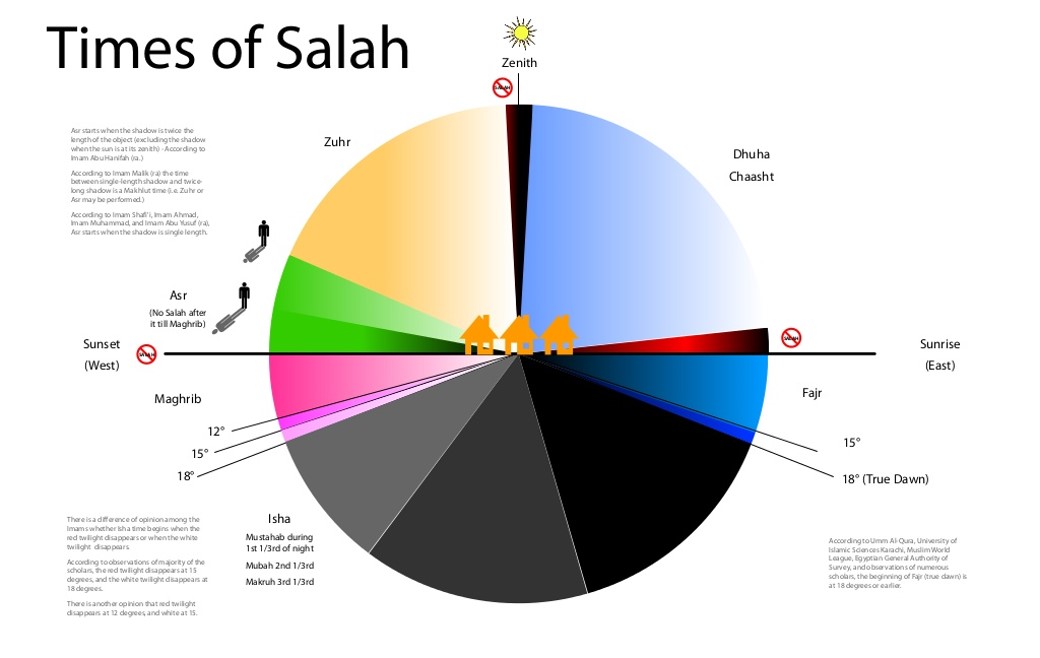
In my residing area of Kirklees, encompassing over 50 Islamic institutions within a 5-mile radius, one would anticipate a uniformity in prayer timetables, given the consistent sunrise, solar midday, and sunset occurrences throughout the year across the three towns constituting Kirklees. However, the proliferation of divergent timetables is a notable anomaly within the region, hinting at a potential fragmentation within the Muslim community. Addressing this fragmentation and fostering unity within the community serves as the primary motivation behind this discourse.
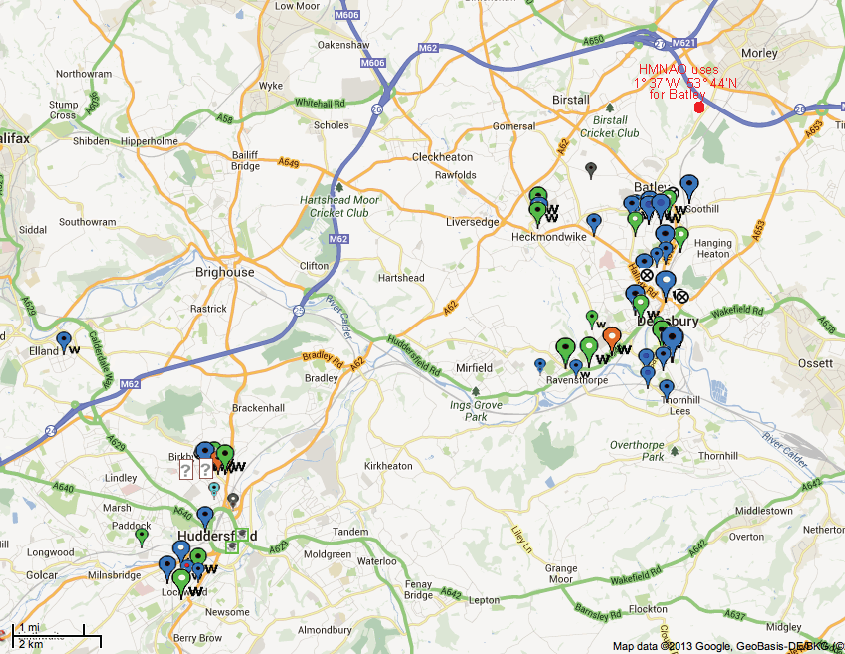
Despite the availability of a singular source of raw data primarily from the HMNAO, leading to near-identical datasets, the divergence in prayer timetables persists. This discrepancy is exacerbated by the visual nature of Islamic prayer timings, which are subject to atmospheric conditions, thus necessitating caution to prevent inadvertent prayers during forbidden times or the inadvertent nullification of Ramadan fasts.
Determining the Start Time of Fajr Prayer in the United Kingdom During Summer
Geographical considerations, especially in the UK, pose unique challenges, notably in determining Fajr and ʿIshā timings. Persistent twilight (shafaq dawām) periods during summer months present a particular challenge, as the sun's depression below the horizon does not reach the required 18° angle, as shown in the fig. below, leading to extended twilight durations. Various methodologies have been proposed to address this issue, including Aqrab-ul-Ayyam, Nisf al-layl, Aqrab-ul-Bilad, and wahid sub' al-layl, each with distinct implications for prayer and fasting times, particularly during Ramadan.
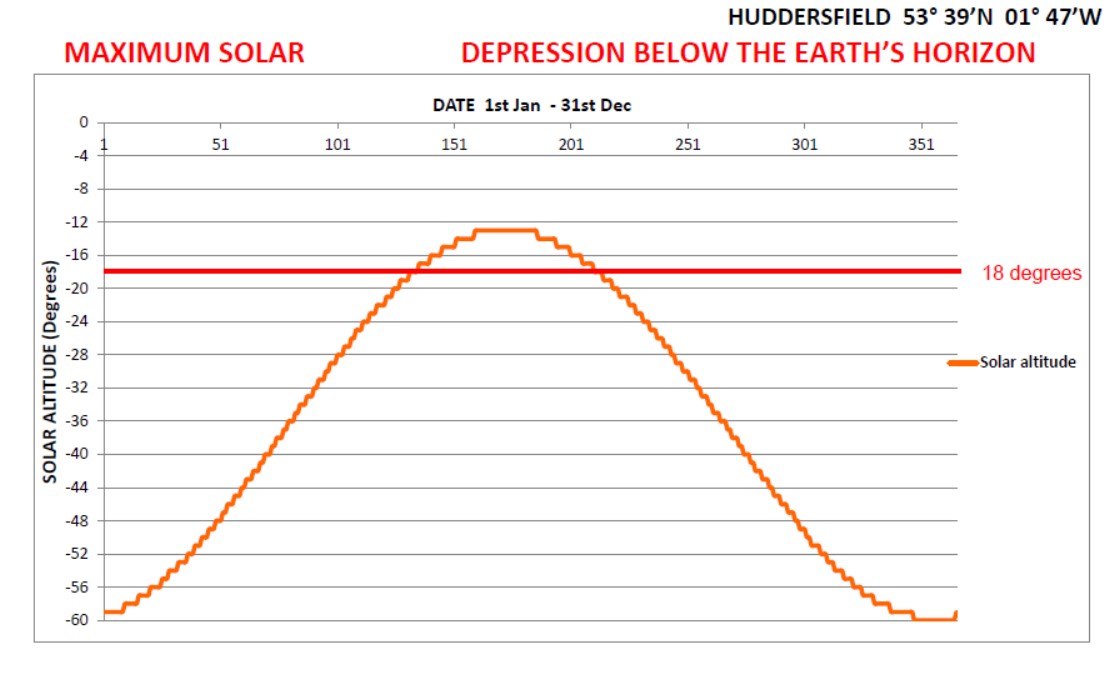
The different criteria used by UK masajid to determine start of Fajr prayers include:
1. 12-13° solar depression
2. 15° solar depression
3. 18° solar depression
4. Wahid sub' al-layl (1/7 of night)
5. Nisf al-layl (midnight/ lower transit time)
6. Aqrab-ul-ayyam (nearest day)
7. Aqrab-ul-bilad (nearest city or place)
8. Fajr starts 1h 30m before sunrise
9. Most will use a combination of the above eight criteria
10. Some do not use any of the above but use data provided by Hizb ul ulema/ CMSC many years ago or they now get their data from moonsighting. com.
In the "wahid sub' al-layl" method, the night (the period between sunset and sunrise) is divided into seven equal parts. Fajr begins after 6/7 of the night has passed.
The overwhelming majority opinion of Islamic scholars throughout history has been the 18° solar depression marking the onset of Fajr underscores the significance of adhering to established principles. However, divergent viewpoints exist, with some advocating for alternative criteria. This discrepancy extends to the determination of ʿIshā timings and raises fundamental questions regarding the universality of the 18° criterion.
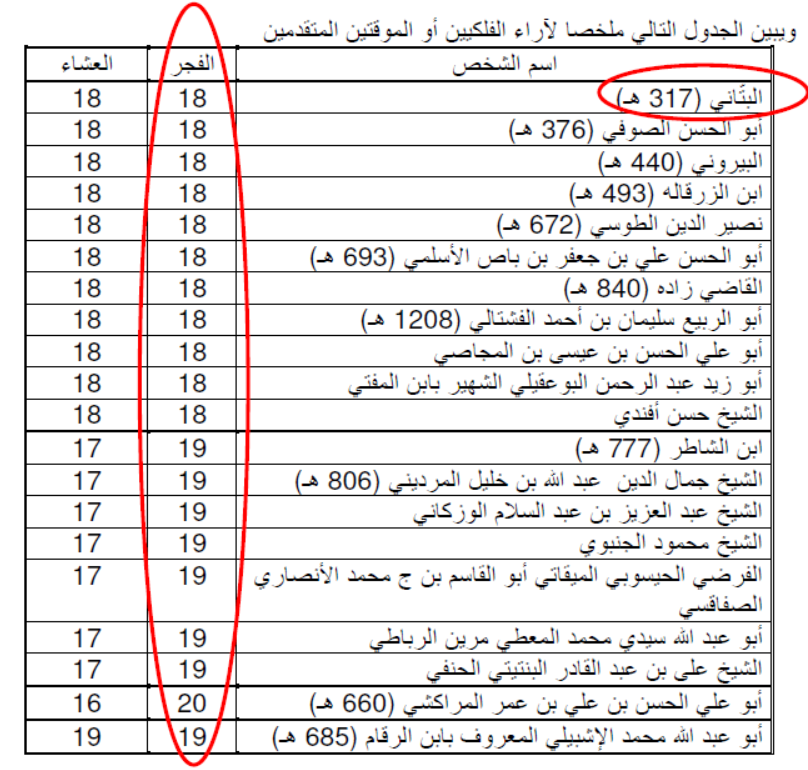
In meetings of UK scholars in 1983 in Bradford and of international scholars in 1984 in London it was agreed to follow the 18° solar depression criteria for the start of Fajr times, as shown below.
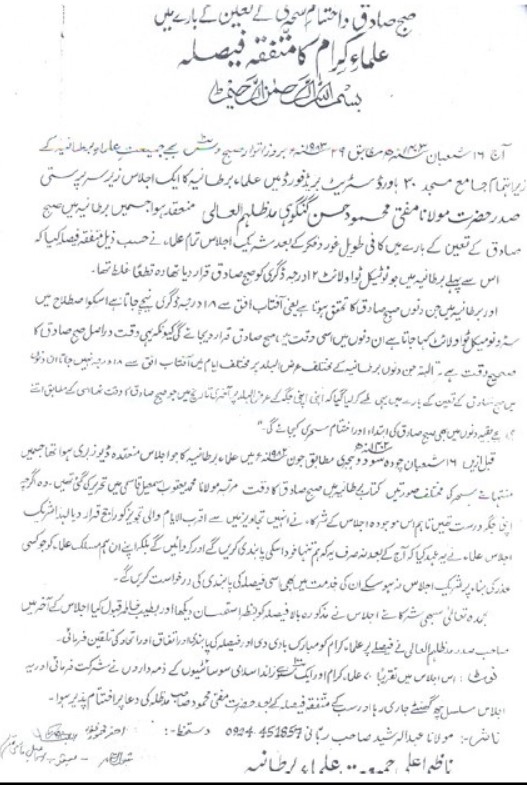
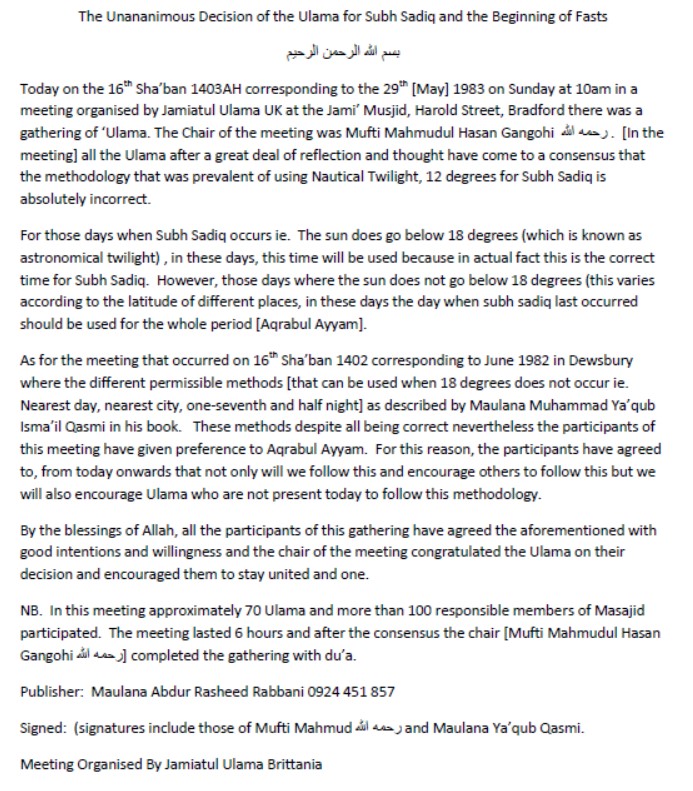
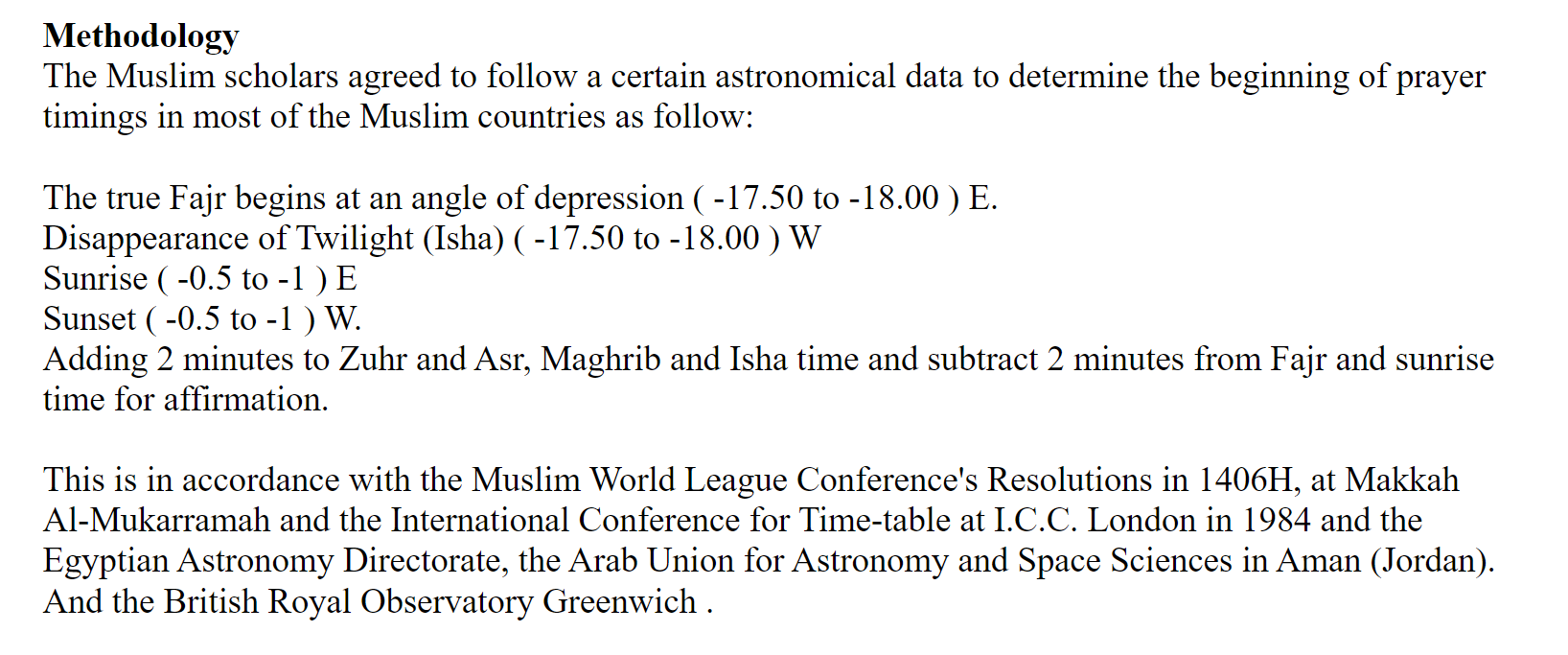
Practical considerations, such as adjustments to raw data and the implementation of precautionary measures, further complicate the construction of prayer timetables. The inclusion of a margin of error becomes crucial, especially during persistent twilight (shafaq dawām) periods, to ensure the integrity of prayer timings and the preservation of fasting rituals.
The graphs below show the duration of the fast when Ramadan occurs during the persistent twilight period in the Summer months. The application of the methodologies of aqrab-ul-ayyam and nisf al-layl result in the duration matching the daylight hours through the year, whereas the methodologies of aqrab-ul-bilad and sub' al-layl result in sudden changes in the duration of the fast from one day to the next, which is totally illogical.

In conclusion, while efforts have been made to standardise prayer timetables and reconcile differing methodologies, challenges persist. It is imperative to remain cognizant of the limitations inherent in determining prayer timings, particularly in regions with unique geographical characteristics. Moreover, fostering unity within the Muslim community requires a collective willingness to prioritise cooperation over individual interests, ultimately serving the greater good of the community as a whole.
15° or 18° for Fajr start time?
This question is most relevant during the month of Ramadan because Fajr start time is also the start of fasting (suḥūr/ sehri time). Mufti Shams Ul-Huda Khan Misbahi of masjid Kan-zul-Iman Jamia Mosque in KIrklees explains.
Does 18° equating with astronomical twilight apply all over the Earth?
Dr. Stephen Bell head of HMNAO answers this question at a meeting organised by Muslims in Greenwich:
Determining the Timing of ʿIshā Prayer in the United Kingdom During Summer
The determination of the timing for the ʿIshā prayer in the United Kingdom (UK) during the summer months is a matter of interpretation and application of Islamic legal principles. According to the teachings of Imam Abu Hanifa (![]() ), the onset of ʿIshā prayer occurs when there is no residual light left in the sky, signifying the disappearance of "shafaq abyad" (whitening twilight) which coincides with 18° solar depression. However, the prominent students of Imam Abu Hanifa (
), the onset of ʿIshā prayer occurs when there is no residual light left in the sky, signifying the disappearance of "shafaq abyad" (whitening twilight) which coincides with 18° solar depression. However, the prominent students of Imam Abu Hanifa (![]() ), namely Imam Muhammad (
), namely Imam Muhammad (![]() ) and Imam Abu Yusuf (
) and Imam Abu Yusuf (![]() ), hold that the commencement of ʿIshā prayer is marked by the disappearance of the sun's red glow, known as "shafaq ahmar" (red twilight), which coincides with 15° solar depression
), hold that the commencement of ʿIshā prayer is marked by the disappearance of the sun's red glow, known as "shafaq ahmar" (red twilight), which coincides with 15° solar depression
The disappearance of "shafaq abyad" corresponds to the conclusion of astronomical twilight, while the disappearance of "shafaq ahmar" aligns with the conclusion of nautical twilight, which occurs at 15° below the horizon. The Hanafi school of thought adheres to Imam Abu Hanifa's (![]() ) stance on this matter. Consequently, many scholars in the UK advocate for the permissibility of using the 15° criterion for determining the timing of ʿIshā prayer. Additionally, the Wifaq-ul Ulema has endorsed a method that limits the ʿIshā prayer time to 65 minutes after astronomical sunset on the longest day of the year.
) stance on this matter. Consequently, many scholars in the UK advocate for the permissibility of using the 15° criterion for determining the timing of ʿIshā prayer. Additionally, the Wifaq-ul Ulema has endorsed a method that limits the ʿIshā prayer time to 65 minutes after astronomical sunset on the longest day of the year.
Various methodologies have been proposed to address the challenges associated with determining the timing of ʿIshā prayer during the summer months. These methodologies include:
1. 12-13° solar depression
2. 15° solar depression
3. 18° solar depression
4. Wahid sub' al-layl (1/7 of night)
5. Nisf al-layl al-shari (half of night)
6. Isha starts 1h 20m to 1h 30m after Maghrib.
7. Most will use a combination of the above.
8. Some do not use any of the above but use data provided by Hizb ul ulema/ CMSC many years ago or they now get their data from moonsighting.com.
In the "wahid sub' al-layl" method, the night (the period between sunset and sunrise) is divided into seven equal parts. ʿIshā begins after 1/7 of the night has passed.
An analysis of generated timetables reveals that the interval between Maghrib (sunset) and ʿIshā prayer varies depending on the methodology employed. Utilising either the 15° or 18° criterion combined with the "sub' al-layl" method yields intervals ranging from 54 minutes to 1 hour and 46 minutes. However, the timing of ʿIshā prayer remains consistent when using a fixed upper time limit or the interval between astronomical sunset and ʿIshā prayer.
Consistency in applying legal theory is emphasised, particularly concerning the choice between different rulings issued by Islamic authorities. It is essential to adhere to the rulings of a specific authority for both Fajr (dawn) and ʿIshā prayer times. Additionally, the importance of Fajr start times, which coincide with the end of suḥūr (pre-dawn meal) during Ramadan, is underscored.
The significance of revising prayer timetables based on accurate methodologies is acknowledged, despite potential resistance from local communities. Scholars urge a proactive approach to address discrepancies and ensure adherence to Islamic principles. The article concludes by providing a timetable for Huddersfield, developed using the 18° solar depression criterion for Fajr times, and the concept of aqrabul-ayyam for subh sadiq during the persistent twilight (shafaq dawām) period in the Summer months and the 15° solar depression criterion combined with the "sub' al-layl" method for ʿIshā times. Scholars are invited to review and validate the timetable, fostering dialogue and refinement in the process of determining prayer times.
The whole year prayer timetables for Huddersfield is attached below as files for download.
Prohibited and Makrūh Prayer times in Islam
Time between after Fajr and Sunrise
Hanafis consider it makrūh tanzīhī to perform nafl (voluntary) prayers during the time between after Fajr and sunrise. It is important to note that this ruling does not apply to qaḍā' prayers or sunnah mu’akkadah prayers.
Ḍuhā prayer (Al-Ḍaḥwa al‑Ṣughrā/ Shuruq prayer)
Begins when the Sun is elevated one spear length (12 spans), and lasts until Istiwā which translates to approximately 4.5° in astronomical terms although 5° has also been documented, corresponding to approximately twenty minutes after sunrise. This astronomical measurement should be corrected for atmospheric refraction and calibrated relative to the observer's apparent horizon. Ḍuhā prayer consists of between two and eight rakats.
According to the Ḥanafīs, Ḥanbalīs and Mālikīs the Eid prayer is from Ḍuhā to Istiwāʾ.
It is prohibited to pray at sunrise.
Al-Ḍaḥwa al‑Kubrā (Nisf al‑nahār al‑sharʿī)
This represents the Islamic legal midday. It is the exact midway point between the beginning of Fajr (true dawn) and Maghrib (sunset). It changes daily due to the changing times of Fajr and Maghrib throughout the year.
According to the Ḥanafīs, al-Ḍaḥwa al‑Kubrā marks the deadline for making the intention (niyyah) to fast for specific types of fasts, including Ramaḍān fasts, specifically vowed fasts, and voluntary (nafl) fasts. One may make the intention anytime from Maghrib of the previous day until al-Ḍaḥwa al‑Kubrā of the day of fasting provided one has not consumed anything or engaged in any act that would invalidate the fast after Fajr began.
It's worth noting that this ruling differs for make-up fasts (qaḍā') and expiatory fasts (kaffārah), which require the intention to be formed strictly before Fajr.
Time between al-daḥwa al‑kubrā and Zawāl
The Hanafis consider it increasing makrūh (disliked) to perform voluntary (nafl) prayers as the time of zawāl approaches. Obligatory (farḍ) and missed (qaḍā') prayers are still allowed.
Istiwāʾ (Wuqoof)
Istiwāʾ marks the precise moment the sun reaches its zenith in the sky, a brief period when prayer is strictly prohibited in Islam to avoid resemblance to sun-worshippers who prostrate to it. At this time, the shadow of an object cast by the Sun is at a minimum. This time is very close to transit time and approximately 5-10 minutes before the start of Ẓuhr prayer.
Zawāl
This occurs immediately after istiwāʾ, when the sun begins to decline from its peak and moves westward. Zawāl literally means to decline or shift. In Islamic jurisprudence, zawāl refers to "the sun's movement from the middle of the sky toward the west". At this time, the shadow of an object cast by the sun begins to increase in size. Ẓuhr prayer starts at the time of zawāl. According to the Ḥanafīs and Shāfiʿīs, the time for the Friday prayer (ṣalāh al-Jumuʿah) is the same as Ẓuhr.
Nisf qaws al‑nahār al‑ḥaqīqī (transit time)
This is the time when the sun is at the observer's upper meridian, reaching its highest position in the sky (azimuth 180°). This is an exact calculated time, which is quoted on HMNAO raw data. This is the midpoint between sunrise and sunset, a calculation of time. Due to the Earth’s tilt and orbit, the transit time may not always align with istiwāʾ time (-179.7° to 180.3°). For Huddersfield, the difference between istiwāʾ time and transit time will be about 1 min.
Makrūh time for 'Asr
The Hanafis consider it makrūh tahriman to delay the 'Asr prayer until the Sun's appearance visibly changes, a practice known as karāhah. This change occurs when the Sun reaches approximately a spear's height (12 spans) above the horizon, which translates to 4.5-5° in astronomical terms and corresponds to about 20-50 minutes before Maghrib for Huddersfield. Despite this prohibition against intentional delay, 'Asr prayer remains obligatory during this time, and if performed, it is still valid. Those responsible for determining jamaat prayer times in the masjid must ensure this makrūh time is avoided. Also, note that most masjid prayer times add about 5 minutes to the start of Maghrib time, which means you cannot offer your 'Asr prayer 3-5 minutes before the published masjid prayer time. If pushed for time, you must start at least your 'Asr prayer before Maghrib time starts.
Illustration of karāhah (makrūh) times calculated at 4.5° for Huddersfield (my home town) are shown below. Since sunset times change rapidly at certain times of the year it would be necessary to calculate the karāhah times, ideally, on a daily basis for the whole year when preparing the annual prayer timetable if your masjid's practice is to offer 'Asr late.
Sunset/ Maghrib time
Sunset is when the trailing limb of the Sun disappears completely below the horizon. It is prohibited to offer prayers when the sun is setting. According to the Ḥanafīs, the Maghrib time ends with the disappearance of the white twilight glow of the Sun.
Ishtibāk al‑Nujūm
Literally means when stars become abundant and widespread in the sky after sunset. This time refers to a celestial phenomenon wherein the stars in the night sky appear so densely packed that they seem to intermingle or blend together. In astronomical terms, this occurs when the sun reaches approximately 10° below the horizon. According to the Hanafis, the recommended time to pray Maghrib is immediately after sunset and before ishtibāk al‑nujūm occurs. Deliberately delaying the Maghrib prayer until after ishtibāk al‑nujūm is considered makrūh tahriman by the Hanafis. The current practice of all the masājid in my area is to offer Maghrib prayers immediately after sunset +3-5 minutes. The Prophet (![]() ) said: "My nation will continue to be upon righteousness as long as they pray Maghrib before the sky fills with stars."
) said: "My nation will continue to be upon righteousness as long as they pray Maghrib before the sky fills with stars."
Makrūh time for Maghrib
The Ḥanafīs deem it makrūh to delay the Maghrib prayer until ishtibāk al‑nujūm, which translates to the sun's altitude angle of -10°.
End time of 'Isha time
According to the Hanafis, the time for 'Isha prayer extends from the disappearance of the twilight (after Maghrib) until the break of true dawn (the beginning of Fajr time). It is makruh tanzihan to delay 'Isha past the legal half the night (nisf al‑layl al‑sharʿī), which is midway between Sunset and Fajr.
A. Hussain
Update July 2024
By request, I have uploaded the raw data for Manchester (U.K.) for the years 2023 (non-leap year) and 2024 (leap year) obtained from HMNAO, http://astro.ukho.gov.uk/websurf/, when they used to provide this information to the public. See the attached PDF files below.
In order to construct a prayer timetable using the raw data please read the above article, in particular, note that:
- Historically, Fajr start times (subh sadiq) have been equated with 18° solar depression.
- It is forbidden to pray when the Sun is at its highest point in the sky from a particular location i.e. when the Sun is at the upper celestial Meridian (also known as upper transit time or solar noon.) Therefore, you should wait a few minutes (3-5 min) after the predicted astronomical upper transit time (solar noon) before offering ṣalāh al-Zuhr.
- Predicted astronomical sunset is when the Sun's centre is 0.833° (0° 50') below the Earth’s horizon. You should delay offering ṣalāh al-Maghrib and breaking fast (futoor) for 3-5 minutes from the astronomical predicted sunset times to allow for altitude and refraction variability due to atmospheric conditions.
During the summer months in Manchester (U.K.) the maximum solar depression does not reach 18° (shafaq abyad) nor 15° (shafaq ahmar). So a combination of methods is used to estimate ʿIshā prayer start times during these summer months. You may also find the algorithm used by HMNAO displays both 00:00 and 24:00 in the raw data to denote midnight.
_____________________________________
Update for Huddersfield Nov. 2024
HMNAO (Her Majesty's Nautical Almanac Office) stopped providing prayer times data for Muslims due to several technical and interpretational challenges, although it seems that this may be available for purchase. Even though sunrise and sunset times remain constant over a human lifetime so that the same data can be used every year, certain challenges do arise.
Analysis of historical data from the HM Nautical Almanac Office (HMNAO) for Huddersfield reveals that Islamic prayer times exhibit a predictable 4-year cycle linked to the Gregorian leap year. This cyclic pattern allows the use of data from four consecutive years to calculate prayer times for subsequent cycles, with necessary adjustments for the start and end dates of British Summer Time and Greenwich Mean Time.However, the phenomenon of persistent twilight during the summer months, which affects the timing of ʿIshā and Fajr, does not follow a simple repetitive pattern. This period typically begins on May 12th or 13th and ends on July 30th or 31st, but no consistent pattern of recurrence has been observed.
Additionally, the occurrence of Ramadan during summer months with persistent twilight (shafaq dawām) follows a 33-year lunar cycle. In Huddersfield, this phenomenon spans nine to ten consecutive years within each cycle. The next such period will occur from 2044 to 2052. This highlights the need for careful planning and local adjustments during these unique periods to ensure accurate and practical prayer timings.
The other issue is that of Fajr start times using the aqrabul-ayyam method. These times vary from year to year. Fortunately, we have data for these years from HMNAO. During the 2013 to 2021 cycle the times for Fajr start times varied from 01:14 Hrs in 2018 to 01:30 Hrs in 2017.
In conclusion, for Huddersfield, since we have the HMNAO raw data for 4 consecutive years as well as all the necessary data for determining Fajr start times during persistent twilight (shafaq dawām) periods, we can continue to construct an accurate, evidence-based annual prayer timetable using the same criteria as we have in the past. All the relevant data has been posted in this article and the attachments below contain prayer timetables for the years 2022 to 2025 in PDF format. The raw data printouts from HMNAO for 2025 to 2028 both for 15° and 18° are attached. I am unable to load MS Excel files for some technical reason. You may request this by sending an email to ahussain1999@doctors.org.uk
It should be noted that 5 minutes has been added to both the upper transit times (solar noon) and sunset times to the HMNAO data to establish the start times for Zuhr and Maghrib prayers, respectively. This adjustment is intended to prevent prayers from being performed during the prohibited times and to account for altitude and atmospheric refraction variability.
It is crucial to clearly indicate these adjustments on the prayer timetable to avoid misunderstandings. For instance, individuals performing 'Asr prayer might inadvertently begin 2–3 minutes before the published Maghrib time, mistakenly assuming they have additional time before Maghrib begins. Such clarity helps ensure that prayers are offered within their prescribed timeframes and in accordance with Islamic guidelines.
Update for Manchester 2025
To minimise potential disputes, I have uploaded the raw astronomical data from HMNAO (Her Majesty's Nautical Almanac Office) for the years 2025 and 2026. The data for 2023 and 2024 had already been uploaded. Using this raw data for four consecutive years, prayer timetables for subsequent years can be generated by applying your masjid's specific criteria through a spreadsheet.
Additionally, I have included a sample prayer timetable for the postcode M13 9WL (Manchester Royal Infirmary), based on the criteria utilised by my local mosque. The details of these criteria are provided within the timetable itself. If you need any further information, feel free to contact me.
A. Hussain
| Attachment | Size |
|---|---|
| Central Manchester HMNAO raw data 2025.pdf | 464.73 KB |
| Attachment | Size |
|---|---|
| Central Manchester M13 9WL HMNAO raw data 2025_20226.pdf | 280.03 KB |
| Attachment | Size |
|---|---|
| MFT Prayer timetable PDF.pdf | 434.95 KB |
